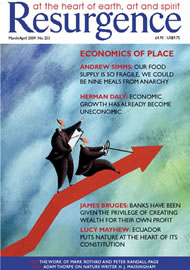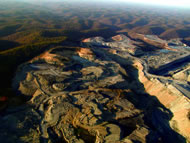IMAGINE A MOUNTAIN in the United States’ Appalachian region, cloaked in green. A spring morning, with mist rising and the air alive with birdsong. A riot of wild flowers splashes the forest floor. In the canopy of a massive tulip poplar, warblers flit among the gauzy leaves, singing to potential mates. Black bears amble about the woods, seeking calories to replace those consumed during a long winter’s nap.
This is a community powered by sunlight. Ecologists have lately become adept at tracking energy as it flows through ecosystems, but even the most sophisticated schematic of food webs presents only a partial picture of reality. Nature’s energy economy is amazingly elegant. There is no waste: only food for another organism. Not quantifiable by any data set, however, is the beauty of life. This temperate forest ecosystem covering these ancient ridges is the biologically richest region in North America, and among the most aesthetically pleasing.
The mountain in mind – the one I’ve asked you to imagine – is a glorious place, typical of myriad real places in the Southern Appalachians, now being obliterated by surface coal mining.
Human beings are not the authors of this wondrous beauty and ecological vitality. The land’s richness is of itself, and for itself. We did not make it – but we are unmaking it with a brutality that is breathtaking to behold. There is a name for this unmaking of the wild world: efficiency. The horror that is mountaintop removal coal mining – a perfect storm of an ecological and social tragedy – is, by the logic of the marketplace, an efficient utilisation of resources, a normal and predictable consequence of an economy based on converting natural capital into commodities.
Return again to the mountain in your mind’s eye, the one alive with creatures going about their business. Now the forest is bulldozed into a pile and set ablaze. The topsoil, source of all life, is scraped away and buried under a mountain of rubble. Now a series of holes are drilled into the body of the Earth, filled with explosives, and detonated. Picture the mountain blown apart piece by piece, dismantled by gargantuan machinery to expose thin veins of dark, carbon-rich rock. The rock we burn to keep the lights on.
It seems to me deeply ironic that the peril now facing the biosphere – a radically disrupted climate due to modern industrial humans transferring molecules of carbon from underground repositories into the atmosphere – stems from perfectly benign natural processes. Long ago, in a time so far removed from human history as to be unimaginable except to a few odd cranks called geologists, the sun shone. Plants grew and died, and the organic detritus accumulated. Over aeons, geological processes shaped and squeezed that detritus into various forms of carboniferous matter. Much, much later, when humans appeared on the scene, these dark rocks came to fuel the fires of the Industrial Revolution, befoul the skies of London and other cities of the newly developing world, and power up our iPods.
FOSSIL-FUEL EXPLOITATION set in motion a positive feedback loop whereby technological innovation spurred fossil-fuel exploitation, and the energy from those fossil fuels powered economic growth and further technological innovation. Initially, muscle power from people and domestic animals was adequate to access coal seams near the surface. But deeper mining was limited until the invention of the steam engine allowed mechanical pumps to clear mine shafts of pooling water. Coal-powered engines and pumps, introduced in England in the early 1700s, allowed workers to dig deeper and access more coal. Thus, the carbonised bodies of plants fuelled by ancient sunlight fostered the Industrial Revolution. Coal, and the engines it could power, helped set society on a particular course – one towards ever greater technology, specialisation, globalisation and economic expansion.
Humanity’s adoption of coal power didn’t just make possible a particular kind of economy and the social organisation that went with it, but also helped fuel a particular worldview, a philosophy of unlimited economic growth based on ever more complex technology. And this was the greatest lingering curse from the original sin of coal mining – the further estrangement of people from Nature. Instead of our rightful place as “plain member and citizen of the biotic community”, as the great conservationist Aldo Leopold phrased it, humans would assume the role of lord, conqueror of the Earth. The power of burning rocks was not solely responsible for the schism between humanity and non-human Nature, but it certainly helped fuel anthropocentric hubris and the swathe of destruction it would wreak across the globe.
The mountaintop removal mine may be the ultimate manifestation of modern industrial people’s ideology of conquest. It symbolises a sociopathic culture, a culture so thoroughly divorced from its roots in wild Nature that it views the living Earth merely as a smorgasbord of ‘resources’ for exploitation and profit. Blowing up mountains and burying streams in pursuit of coal is a practice that could only be conceived by people who have forgotten – or reject – our species’ kinship with all of life. It is a form of violence against the land so rapacious that it literally condemns mountains to death. It ignores the fundamental need for health. It promotes sickness. It is utterly contemptuous of the future. It is one generation of humans saying to other members of the land community, “You don’t matter,” and to our own descendants, “Screw you, I got mine.”
The radiological poisons humans have created during the nuclear age may be deadly ten thousand years from now, but the geographical engineering that is presently being accomplished in Appalachia by coal companies operating mountaintop removal mines is essentially permanent. The corporations that are scalping mountains and helping turn an entire region into an undeclared national energy sacrifice zone are powered by greed. On behalf of their shareholders, on behalf of the electric utilities that are the major customers for the coal, on behalf of every consumer who believes in the myths of “cheap” energy and “clean” coal, the mining companies are waging war on the wildlife and people of Appalachia. And they are winning.
WHILE THE MOUNTAINTOP removal mine may be an apt metaphor for a society based on cancerous growth, the practical effects of surface coal mining on the natural and human communities of Appalachia are anything but symbolic. They are everyday realities for people living throughout the coalfield counties of Kentucky, West Virginia, Tennessee and Virginia. Air and water pollution, overloaded coal trucks travelling narrow mountain roads, forest fragmentation, excessive levels of coal dust, massive coal slurry impoundments perched over communities, degradation of headwater streams – these and other effects are suffered by people and wildlife across the region.
The more than 470 mountains that have already been blown apart as surface coal mining has become more and more radical in its destructive power will not grow back. Erosion, deposition, tectonic action – it is for geological processes now, over the course of deep time, to soften the scars on the land. The damage will be visible as long as humans walk the Earth. •








